Today we went on our first Escapee's HOP. We met everyone else at a little after eight in the Grandstand Building. Breakfast was available if we wanted it.
By 8:20 or so we loaded onto the bus to start our adventure. Destination? First stop - Mount Rushmore.
We pulled into a rest stop where I got this first picture taken.
There was a large cement teepee of sorts as a monument to the Indians of the area.
We had a local third grade school teacher, Kathy, on the bus with us and she pointed out things and told us the history of the area as we rode along.
Several hours later we finally arrived at....
First stop for us was the cafe to get some lunch since we didn't partake of the breakfast that was offered.
After filling our tummies we walked through the state flags to get to the viewing area. Each pillar that held the flags had the state name engraved and the date it was admitted to the Union. Needless to say, Delaware held the place of honor as being the first, first state and first pillar.
Then it was before us.
You can see in the picture above that there are workers standing on Roosevelt's head, they are doing repairs to cracks.
Words taken from plaque:
The four American presidents carved into the granite of Mount Rushmore were chosen by the sculptor to commemorate the founding, growth, preservation and development of the United States. They symbolize the principles of liberty and freedom on which this nation was founded. George Washington signifies the struggle for independence and birth of the Republic; Thomas Jefferson the territorial expansion of the country; Abraham Lincoln the permanent union of the states and equality for all citizens and Theodore Roosevelt, the 20th century role of the United States in world affairs and the rights of the common man.
The men who carved Mount Rushmore were residents of the local area, many were ranchers, miners or lumbermen. It took fourteen years of carving for the 400 men and women who labored on the Memorial. The work was hard, the hours long, the pay low and employment not always guaranteed. Work started at 7:30 in the morning and to get to their work areas they had to first climb 700 steep steps to the top of the mountain. The men were strapped into swing seats and then lowered over the face of the mountain with the tools of their trade, heavy drilling tools and blasting equipment. For some it was just work, for others it was a special calling.
Some facts about Mount Rushmore:
- Borglum, the sculptor, was 60 years old when he began working on the monument.
- Rushmore's granite faces tower over 5,500 feet above sea level.
- The carvings are scaled to men who would stand 465 feet tall.
- Each President's head is as tall as a six-story building.
- Over 800 million pounds of stone was removed from Mount Rushmore during the construction.
- Imagine climbing 506 steps to reach the top of Mount Rushmore-this was how many steps the workers had to climb each day!
- The president's noses are 20 feet long, their mouths 18 feet wide, and their eyes are 11 feet across!
- Gutzon Borglum was a student of renowned French artist Auguste Rodin, and was one of America's most successful artists before even considering Mount Rushmore? His Mares of Diomedes was the first American work purchased by New York's Metropolitan Museum of Art. He also has 5 statues on display at the U.S. Capitol Building.
- Here is an astonishing fact: no deaths occurred during the whole period of carving, just a few minor injuries. (Can you imagine that with all the dynamite used?)
Since there is no President Rushmore had did the name come about?
Well, it seems that in 1885, a New York lawyer was surveying and researching mining claims for area mining companies when he asked his guide the name of the particular mountain. Charles E. Rushmore reportedly got the answer that was to immortalize his name forever on the landscape. “Never had one. But, hereafter we call ‘er Rushmore, by jingo!” The U.S. Board of Geographic Names made it official on July 4, 1930. Now you know.
All too soon we had to leave to get on with our tour of another attraction.
Our next stop was the Crazy Horse Memorial. This is a work in progress and when it is done it will be largest mountain carving in the world.
This carving has NO state or federal funding. It is done strictly with the funds from John Q. Public and area businesses, some of which will donate an item for raffle, the proceeds going to the Memorial.
Below is a sculpture of what it will look like when completed.
The first blast, which took place on June 3, 1948, yes you read that right, 1948 removed just 10 tons of dirt and rock. Millions of tons have been removed since. At the present time workers are blocking out the 22 story high horse's head. You can see the painted outline of the horse on the side of the mountain.
Fifty years to the day, after the first blast, the nine story high face of Crazy Horse was unveiled at the dedication.
The head of Crazy Horse on this monument is 87.5 feet high and the arm is 263 feet long. Looking at the picture above you can see a hole under the arm. That "hole" is three stories high! Just above the hole you can see something white. That is a huge sign that could be read even though we were one mile away from the monument. The sign read, "Happy Birthday Ruth". Ruth is the wife of the man who was commissioned to "build" this monument. She and seven of their ten children are carrying on the plans of sculptor Korczak Ziolkowski. They all work on some aspect of the monument.
There is quite a complex here at the monument that contains a museum, a conference center, restaurants, gift shops, showroom, the Native American Cultural Center and twin theaters to name a few.
This is called the Black Hill Nature Gates....
A close up of some of the panels.
What the monument looks like today...and what it WILL look like...someday.
We both would have liked to spend a lot more time here as we didn't get to see even a quarter of the complex in the time we had here. This is a place we'll come back to again.
Our next stop was the Vore Buffalo Jump on the way home.
The first thing we noticed was the teepee.
The big draw was this hole in the ground.
Several of our group walked down to the white tent which is covering an archaeological dig.
Here's what took place here.
Between 1500 and 1800 A.D. the ancestors of at least five plains Indians tribes killed and butchered as many as 20,000 bison at what is now known as the Vore Buffalo Jump. Herds of bison were gathered from the surrounding valley and stampeded over the edge of the sinkhole. This provided tons of meat for winter storage. Thick layers of butchered bone extend almost 20 feet below the floor the the hole.
This has been a long day. Its a trip we're glad we took and a trip we were glad when it was over!
Note to self: Do NOT, ever, EVER, sit in the back of a bus. Motion sickness can creep up on you even on one of these things!
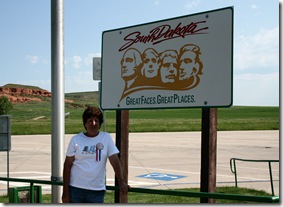
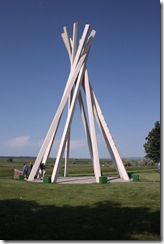
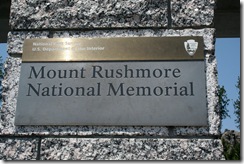
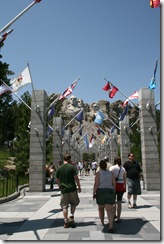
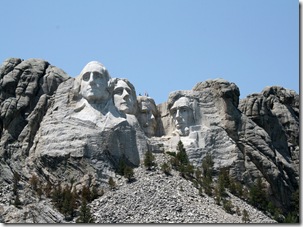


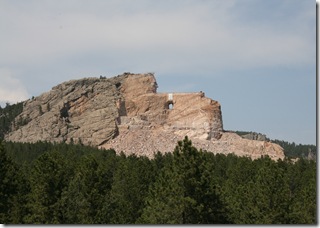
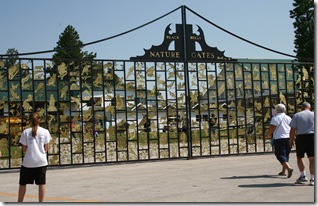
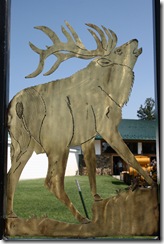



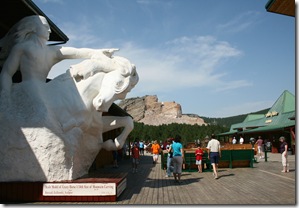
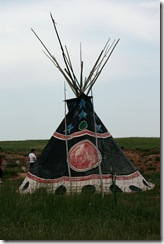
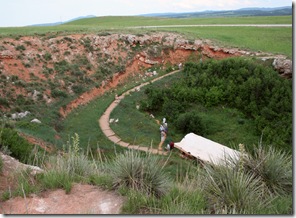
1 comment:
I remember a brave girl who jumped out of a perfectly good airplane at 13,000 feet!! What were you thinking????
Post a Comment